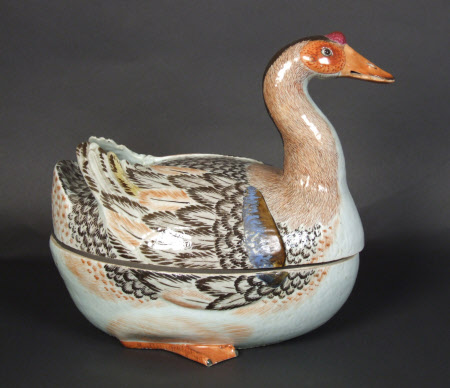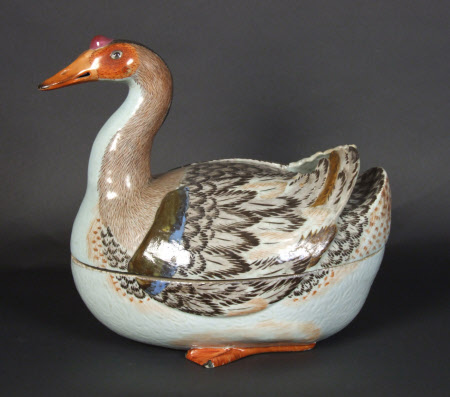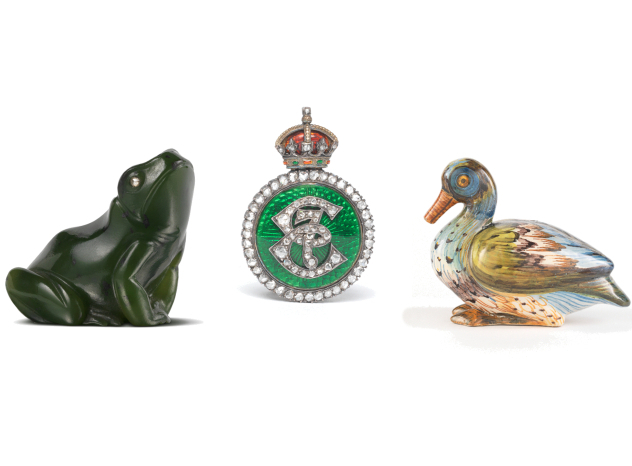Pair of tureens
Category
Ceramics
Date
c. 1760 - 1770
Materials
Porcelain, enamel
Measurements
34 cm (H), 23 cm (W), 37.5 cm (D)
Place of origin
Jingdezhen
Order this imageCollection
Polesden Lacey, Surrey
NT 1245506
Summary
Pair of tureens, porcelain, each in the form of a seated goose, made in Jingdezhen, Jiangxi Province, and decorated in Guangzhou (Canton), Guangdong Province, China, c. 1760–70. With an incised ground of feathers painted in polychrome enamels in a naturalistic palette of black, brown, orange, red and blue.
Full description
The production of animal-shaped porcelain tureens in China appears to have been inspired by the European taste for tureens in the form of animals, birds, fish, fruit and vegetables, which emerged in the 1740s (see Ferguson 2024). Exactly who or what was the catalyst for the first commission of such tureens in China is not known, but there are references to them being brought to Europe in the records of the Danish and the Dutch East India Companies (during the periods 1759–65 and 1763–4 respectively) and in the cargo register for the Spanish ship Nuestra Señora del Carmen (in 1769; see Sargent 2024). The cost of making these relatively complicated shapes, their fragility during transport and possibly other fluctuating economic and taste factors appear to have limited the period during which they were made. Consequently, Chinese goose-shaped tureens are relatively rare, which may have been one of the aspects that made them appealing to Margaret Greville.It seems likely that the Chinese porcelain suppliers responded to the European requests for goose-shaped tureens by modelling them on a local breed, the Chinese swan goose (Anser cygnoides), with which they were familiar. The natural habitat of the large swan goose is in Mongolia, but they overwinter in the Yangzi basin, and their meat is considered a summer delicacy. In Chinese art pairs of geese symbolise peace, prosperity and marital fidelity (see Bjaaland Welch 2008). Almost identical goose-shaped tureens are in the collection of the Metropolitan Museum of Art, New York (inv. no. 51.86.78a, b), the Victoria and Albert Museum, London (inv. no. 72-1884; see Kerr and Mengoni 2011) and the Winterthur Museum, Delaware (inv. no. 1961.0870 A, B). For several other almost identical tureens see Vinhais and Welsh (eds.) 2024.
Provenance
Listed in the Dining Room at Polesden Lacey in the 1943 probate inventory (p. 6); bequeathed to the National Trust by Dame Margaret Greville, DBE (1863-1942).
References
Bjaaland Welch 2008: Patricia Bjaaland Welch, Chinese Art: A Guide to Motifs and Visual Imagery, Tokyo, Rutland (Vermont) and Singapore, 2008, p. 75 Ferguson 2024: Patricia F. Ferguson, 'Fashioned after Nature: European Trompe l'Oeil or Animal-Form Ceramic Tureens', Vinhais and Welsh (eds.) 2024, pp. 41–61 Howard 1994: David S. Howard, The Choice of the Private Trader: The Private Market in Chinese Porcelain Illustrated from the Hodroff Collection, London, 1994, pp. 576 and 590-1 Kerr and Mengoni 2011: Rose Kerr and Luisa E. Mengoni, Chinese Export Ceramics, London, 2011, pp. 78-9, pl. 110 Sargent 2024: William R. Sargent, 'The Allure of Chinese Export Porcelain Animal-Form Tureens: Artistry and Functionality', Vinhais and Welsh (eds.) 2024, pp. 19–40 Vinhais and Welsh (eds.) 2024: Luísa Vinhais and Jorge Welsh (eds.), Animalia: Chinese Export Porcelain Animal-Form Tureens, London, 2024, cats. 29-32





